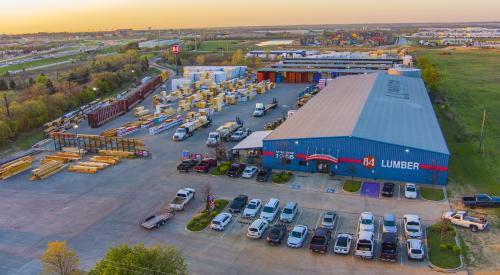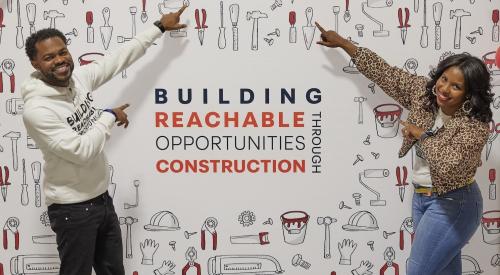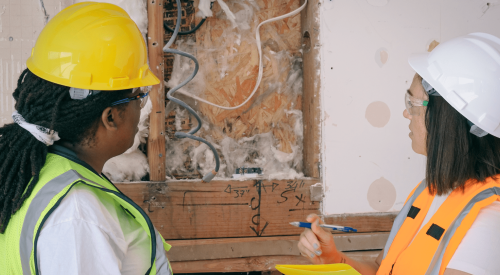
President
Orion Novotus
Orion Talent has a 30-year heritage as a national provider of recruiting resources for military veterans. In 2016, the firm, headquartered in Raleigh, N.C., acquired Novotus, a full-service recruiting company and recruitment process outsourcing leader, expanding its scope of services and the industries it serves to include construction, in addition to technology startups and Fortune 100 companies in auto-parts manufacturing, energy, nonclinical health care, and civil engineering. Along with the challenge of finding skilled workers and managers in a shallow labor pool, company president Cory Kruse says builders and trades must also focus on giving employees a reason to stay in construction, particularly as other industries compete for the same talent.
PRO BUILDER: Residential construction is a fragmented industry with thousands of small builders, many hiring subcontractors to build their homes. Is it builders or the trades that generally seek your recruitment services?
Cory Kruse: We deal with both. We don’t have a large quantity of big, public builders that we service. We do military hiring for a few of them, but most of the hiring we do is for services and manufacturers that support the construction industry or subcontractors that directly service the residential construction market.
PB: Among home builders, which ones do you see stepping up to attract and retain skilled workers?
CK: Well, there are two things at play here. The first is that big builders historically have had bigger budgets, a bigger brand to pull, and can offer what would be deemed a better employee value proposition or experience just because of their size and the funding they may have versus the smaller builder that’s scrapping it out in a region.
But there are some regional builders that have built up a nice business around work consistency and paying their people more money. They recognize that it costs them more to replace than to keep employees, so they’re utilizing some things that big builders may not be able to offer employees, such as more flexibility and things like that.
PB: Why has it been so difficult to fill the skilled construction labor pool?
CK: The bias [of construction employers] toward a specific employee profile, and a general lack of training on the front end, have contributed to the shortage. Typically, the construction industry has been biased against women in specific roles. It also hasn’t focused on training or clearly messaging the employee value proposition to groups beyond the traditional construction worker.
But, in the last 10 years, we’ve seen substantial growth, not just in women-owned construction companies, but now one out of every hundred skilled workers in the field is a woman. [That’s progress,] yet women make up almost 50% of the total workforce.
PB: Are more doors opening for women, vets, and young people to consider and enter careers in construction?
CK: I don’t know if I would say more opportunity. I think opportunity has always existed for women and other groups of talent, it’s just that construction companies haven’t always embraced it or focused on those groups.
Historically, the construction industry is cyclical, and that has driven talent acquisition behavior to be almost just-in-time. [Builder thinking goes:] We’re not going to look for people to hire until we need them—and we all know that’s potentially disastrous, especially during an economic upswing.
I’d say the visibility and the awareness of a possibly greater talent pool is definitely more prevalent now because it’s getting tougher to recruit and retain workers. We’re not seeing the number of folks we used to entering the trades early, and demand is outpacing that. So I feel the doors are definitely open for other groups right now.
RELATED
- Building the Pipeline for Next-Gen Skilled Labor
- As More Women Enter the Construction Industry, Just 3% Work on Jobsites
- The Great Gender Debate
- Video: Recruiting the Next Generation of Skilled Construction Labor
PB: What other options exist for finding and retaining construction talent?
CK: Companies are looking at employment configurations [such as] temporary workers, thinking ... Maybe, instead of hiring one person who’s gonna bang out 40 hours a week, I can hire two and get two good workers for 20 hours a week. They’re looking at more creative work configurations to meet their man-hour needs and keep up with demand.
PB: What would a good employee value proposition look like? What are construction companies not doing in terms of presenting that message?
CK: I'll give you two examples. One is an example that's not very compelling. The other is an example that would be more likely to compel somebody to take action and apply for the job or to take a look at the construction industry as a potential career. We've got companies that, when they're looking to hire people, may or may not have a website. If they have a website, maybe they have a job posting that says they're seeking a concrete worker or a construction manager. The posting describes the job and what's required, and that's it, right? And there's probably a clunky way to send in your resume. Sometimes there's nobody managing that process on the back end, so there's no real strategy around the employee attraction piece. Maybe the builder takes out some ads, but there's no analytics around it. There's no target, a target like: We have to get a hundred people in our pipeline to get 10 interviews to hire two people.
On the other side of the scale, if I go to a website and a company has a video of somebody who came out of high school who is going through training, that paints a picture for the candidate that they can wrap their head around, that's real; I can feel what it's like to work for this company. Hey, I'm not only going to be picking up nails and putting stuff in the trash; I'm going to learn to do takeoffs, or estimates, or to use a specific technology, or operate heavy equipment. There is a progressive career path that's tangible to me that I can feel and taste, and I'm compelled.
PB: What keeps you up at night in terms of the demand for skilled labor and the lack of training to increase the available pool of prospects? Do you see training picking up and perhaps narrowing that gap?
CK: Yeah, absolutely. I divide it into two camps. The first camp would be vocational-type training opportunities that introduce young people to construction at an early age—and not only the labor part of it, but opportunities, career paths, and educating them about a bonafide career in construction. There's definitely a shortage of that.
And then No. 2, there’s a shortage of companies willing to invest in a training program as well as a career progression program for employees. That is, not only training them to do a task, but putting them in a career development program that paints the picture I was talking about earlier. We showed you the video, we showed you some cool stuff ... Now here's how you get there. Here's how you get to be a lead, the superintendent, a foreman, a manager.
Typically, construction has been about "I need some help, and if the person swings a hammer well, or does a [particular] task, they get more responsibility." But they still don't see a career path. And then another company comes along and offers 25 cents more an hour and that employee is gone. Those are the two camps.
The other piece of that, which people don't talk about, is that you have multiple industries, not just construction. You've got manufacturing, tech, retail ... all of these companies vying for a similar talent pool for jobs, and they're coming in and wining and dining vocational schools. They're partnering with them; they're investing in them, and to whom do you think the talent is going to go to?
PB: There are home builder associations and major suppliers funding training programs for the trades, so maybe that can boost the talent pool available for construction.
CK: There are, and like anything else, you have to market your way to the candidates. Then you have to reinforce the experience on the back end. Unfortunately, a lot of employers don't make the investment on the front end to talk about why somebody should work at their company and stay there for a while.
But you've got companies in other industries that are getting this type of talent. The other influencer is the work itself. I live in Texas, and I wouldn't wish a roofing job on anybody during the summer in Texas. If you can work and make the same money in an air conditioned manufacturing facility or some other industry with a career path, of course you take that into consideration.
PB: Which residential construction positions are in high demand?
CK: In the trades, carpentry, plumbing, concrete, electrical, stuff like that. There's also demand for construction and project managers, foremen, superintendents—anybody who can direct a group of people to do a task—cost estimators ... and health, safety, and environmental has always been something that has been big, and during this last year, it's become very important.
PB: How has the pandemic affected recruitment?
CK: When the pandemic hit, there was the obvious pause in man hours due to the onset of this thing and all of the uncertainty. Everybody's thinking, How are we going to do this now? You have brakes on the front end with material manufacturing, the supply chains, and other disruptions, like cashflow, combined with an already scarce workforce, not to mention having to deal with local municipalities that are trying to figure it out as well. How do we manage our city, our county, or our state through this when we have all of these construction projects going on?
RELATED
- 5 Initiatives to Address the Labor Shortage Now
- Are There Lessons From the Great Recession for the COVID-19 Pandemic?
- The Best-Kept Secret in Solving the Trade Labor Shortage
They're all over the board. It is absolutely a challenge, and it has also forced companies to embrace and adapt technologies. For instance, with remote-working necessities ... how do we not meet in person but still accomplish collaboration? Do we need to get software and tools into the hands of other people who don't typically use them? Because now we're not face to face, or are distanced, that has led to more investments in technology so we can work in this new environment. Companies had to retool their processes and adapt to a new way of working.
And then ... asking companies to focus on the upstream areas such as trade schools, investing in alternative educational opportunities, looking at flexible employment configurations, as I mentioned before; maybe part-time, maybe temp to hire. In all that, we've seen a few companies take the time to really buckle down and highlight the potential career paths and career growth in residential construction.
PB: If there is a surge of construction after the pandemic, will the competition for skilled workers intensify between residential and non-residential construction employers?
CK: I think it's going to remain intense; as long as the economy ramps up it will maintain the intensity level. So, typically, our other sectors that are vying for the same talent. It's much like the nursing shortage, right? We don't recruit for health care or nursing, but people call us and we say you have a choice. Either you build them and train them and sponsor them yourselves, or you have an employment offering that is better than your competitors'.
Diversity initiatives, such as formal programs around veterans' outreach and recruiting women and minorities, should be employed as part of a total talent strategy and should be the norm.
I think companies need to focus on that upstream, No. 1, tapping into maybe a relatively untapped talent pool and leveraging that and then also focusing on retention practices. One thing that is not often talked about in the construction industry is the high turn. We can talk about the diminishing talent pool and the supply and demand of labor all we want, but unless companies are doing everything they can to keep their folks, it's going to keep pressure on the talent pool.
PB: What would you recommend employers do to retain employees?
CK: When I mention training, one of the biggest things is teaching somebody who's green a new skill. But you should also be equipping young managers and even seasoned managers to develop their talent, know how to better manage their workforce, and how to be the best managers. People typically go to work for people, not for companies, so a good management development program is huge.
Also, folks are looking for perks. They could be monetary, but they're also looking at: What is it like to work here? Why am I here? Why would I leave?
And doing exit interviews and things like that to make sure you're providing the best talent offering you can within your financial capabilities. You do invest a bit more money in people, and that's not only talent acquisition, that's talent management.
PB: What do builders or subcontractors get wrong regarding the talent available to recruiting agencies?
CK: Utilizing outside recruitment resources is definitely nothing new to the construction industry. I mean, from temp workers being used to scale up or down, to fully outsourcing a recruitment program or leveraging a firm like ours to handle everything ... the need for augmentation services as a whole has become necessary and has evolved into more than just finding people.
To give you an example, we work with many of our clients specifically on the front end. Much of what we've talked about throughout this discussion is the talent attraction stage, where messaging outreach and the candidate’s experience can be your competitive advantage right off the bat. A lot of companies are doing these things, but there are small tweaks they could be making to greatly increase their ability to attract and retain the right talent.
In reality, most veterans develop skills during their years of service that translate well into many workplace scenarios ...
In addition, diversity initiatives, such as formal programs around veterans' outreach and recruiting women and minorities, should be employed as part of a total talent strategy and should be the norm.
When I talk to construction company owners or folks running big public companies, the No. 1 thing I say to them is that they have to covet the candidate experience. That is, they have to make sure the experience the candidate goes through with their company is better than that of their competitors, or they're going to lose.
PB: What are functional roles learned in the military that can transfer to construction?
CK: There are the obvious ones. If I was an electrician in the Navy, most of my skills will transfer over, but I think there's a bit more complexity in it and the good news is that the military has been a substantial source of talent for the construction industry for many years. They've got thousands of enlisted individuals, officers, and command staff that make an ideal fit for the construction industry, whether that's because of direct experience or experience working on construction teams to build or repair or service structures.
Veterans without direct military construction experience also are exceptional candidates because of their project management experience or supervisory experience, and most of these folks are adept at working in extreme conditions. Safety plays a big role in construction, and most folks coming out of the military have a component of safety compliance. The very nature of what many veterans do on a daily basis is what many residential builders need, so it does translate.
PB: What stereotypes do employers have regarding veterans that often lead to hiring mistakes?
CK: Sometimes vets are stereotyped as coming out of the infantry or battle. They’re overlooked for specialized roles like technicians, machine operators, construction, medical, stuff like that, which often requires project management experience.
In reality, most veterans develop skills during their years of service that translate well into many workplace scenarios, whether it's in entry-level or management roles, blue or white collar. And so the key is to understand how a military candidate's background and their qualifications translate to the requirements for the position. What are they going to be doing? What's the desired outcome? What overlap is there of their skill sets [with the employer's needs]? When those align, we have seen military hires evolve really well within organizations.
In many of the organizations we work with now, the leadership that had come through the military program—junior military officers, even enlisted [vets]—are now leading large construction organizations.
The other piece is that when somebody is leaving the military, they're leaving a job that required specific training and X number of hours of training. If they come into a very ambiguous environment where there's no, or limited, training, there's shoddy communication, and there aren't many systems, that could be a mistake.













